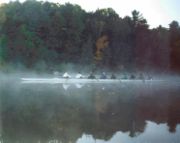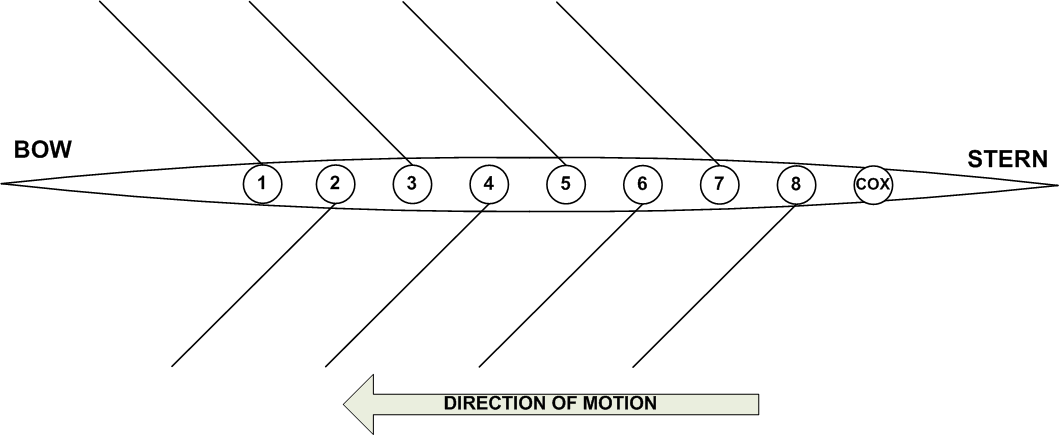
Boat positions (sport rowing)
Encyclopedia

Sport
A Sport is all forms of physical activity which, through casual or organised participation, aim to use, maintain or improve physical fitness and provide entertainment to participants. Sport may be competitive, where a winner or winners can be identified by objective means, and may require a degree...
of rowing
Rowing (sport)
Rowing is a sport in which athletes race against each other on rivers, on lakes or on the ocean, depending upon the type of race and the discipline. The boats are propelled by the reaction forces on the oar blades as they are pushed against the water...
, each rower is numbered by boat position in ascending order from the bow
Bow (ship)
The bow is a nautical term that refers to the forward part of the hull of a ship or boat, the point that is most forward when the vessel is underway. Both of the adjectives fore and forward mean towards the bow...
to the stern
Stern
The stern is the rear or aft-most part of a ship or boat, technically defined as the area built up over the sternpost, extending upwards from the counter rail to the taffrail. The stern lies opposite of the bow, the foremost part of a ship. Originally, the term only referred to the aft port section...
(with the exception of single sculls). The person who is seated on the first seat is always the 'bowman
Bow (rowing)
Bow is a term which has multiple meanings within the sport of rowing. It is used to refer to a rower seated in a particular position and to one side of the boat.-Bow:...
', or more commonly called just 'bow', the closest to the stern is commonly referred to as the 'strokeman
Stroke (rowing)
Stroke is a term which has multiple meanings within the sport of rowing. It is used to refer to the action of propelling the boat with oars, to a rower seated in a particular position and to one side of the boat.-Stroke action:...
' or 'stroke'. There are some exceptions to this: UK coastal rowers and rowers in continental Europe
Europe
Europe is, by convention, one of the world's seven continents. Comprising the westernmost peninsula of Eurasia, Europe is generally 'divided' from Asia to its east by the watershed divides of the Ural and Caucasus Mountains, the Ural River, the Caspian and Black Seas, and the waterways connecting...
number from stern up to bow. Certain crew members have other informal titles and roles.
Rowers
Examples are given for the largest common boat, the sweep oarSweep (rowing)
Sweep or sweep-oar rowing is a type of rowing when a rower has one oar, usually held with both hands. As each rower has only one oar, the rowers have to be paired so that there is an oar on each side of the boat. This is in contrast to sculling when a rower has two oars, one in each hand. In the...
an eight
Eight (rowing)
An Eight is a rowing boat used in the sport of competitive rowing. It is designed for eight rowers, who propel the boat with sweep oars, and is steered by a coxswain, or cox....
, but apply similarly smaller boats and sculling
Sculling
Sculling generally refers to a method of using oars to propel watercraft in which the oar or oars touch the water on both the port and starboard sides of the craft, or over the stern...
boats, eights are always coxed
Coxswain (rowing)
In a crew, the coxswain is the member who sits in the stern facing the bow, steers the boat, and coordinates the power and rhythm of the rowers.- Role :The role of a coxswain within a crew is to:...
.
Stern Pair
The "stroke" is the rower closest to the stern of the boat. Everyone else follows the stroke's timing - placing their blades in and out of the water at the same time as stroke. The strokeman can communicate with the coxswain (when in a stern coxed boat) to give feedback on how the boat feels. During a race, it is the stroke's responsibility to establish the crew's rate (number of strokes per minute) and rhythm. (In coxed boats, the coxswain will assist the stroke in establishing the rate). Because of the great responsibilities, the rower in the stroke seat will usually be one of the most technically sound members of the boat.
Middle Crew
The middle rowers of a crew (numbers 2 and 3 in a four, and 3, 4, 5 and 6 in an eight) are normally the most powerful and heaviest rowers, colloquial known as the Fuel Tank, Engine Room, Power House or Meat Wagon. The boat pitches and yaws less in the middle, and the oarsmen there have less effect on these movements, being closer to the centre of mass and centre of buoyancy. Therefore the rowers in the middle of the boat do not have to be as technically sound or reactive to the movements of the boat, and can focus more on pulling as hard as they can. It is common practice among crews to put the most technically proficient rowers at the bow and stern and the physically strongest and heaviest rowers in the centre.Bow Pair
The rower closest to the bowBow (ship)
The bow is a nautical term that refers to the forward part of the hull of a ship or boat, the point that is most forward when the vessel is underway. Both of the adjectives fore and forward mean towards the bow...
of the boat, is usually called either "bow" or the "bowman". In cox
Coxswain (rowing)
In a crew, the coxswain is the member who sits in the stern facing the bow, steers the boat, and coordinates the power and rhythm of the rowers.- Role :The role of a coxswain within a crew is to:...
less boats, the bowman is often responsible for giving calls to the crew. The bow pair of bow and "two", who are the two rowers closest to the boat's bow, are more responsible for the stability (called "set") and the direction of the boat than any other pair of rowers, and are often very technical rowers. The bow of a stern-coxed boat is subject to the greatest amount of pitching, requiring the bow pair to be adaptable and quick in their movements.
Boats that are bow coxed
Bowloader
A bowloader is a crew shell in which the coxswain lies semi-supine in the bow, as opposed to the normal seated position at the stern.Bowloaders are often seen as coxed fours and also coxed pairs...
rely on communication between the bowman and the cox - as the cox cannot see boats coming up from behind. Bowmen tend to be the smallest of the rowers in the boat.
Steersman
In coxless pairs, quadruple sculls and coxless fours, one of the oarsmen will be designated steersman. They will control the rudder using lines attached to the toe of one shoe, which pivots around the ball of the foot. The steersman is chosen according to experience and the nature of the course on which the boat is rowing: bow has a clear view ahead when looking over his shoulder, whereas stroke may be able to steer well on a straight course by pointing the stern at a reference point. Steersmen rowing in the middle of a four or quad are not uncommon, since bow and stroke have other duties already.Boat Rigging
Traditionally a boat is organized so that alternate rowers row on port and starboard (or strokeside and bowside), with stroke on port side (having their blade to their own right) (strokeside). This is sometimes reversed, so that stroke is on the other side (having their blade to their own left); such a boat is usually described as 'bow rigged'. This is often on the basis of the abilities of the available personnel, to allow putting an experienced starboard side (bowside) rower in the stroke seat, for example. The eight in the photograph at the top of this article is bow rigged.There are other options, and in particular in fours the middle pair may row on the same side: this arrangement means that there is less yawing of the boat through the water throughout the course of the stroke, making it more efficient. The two oarsmen in the middle, rowing in a 'tandem', need to be well matched and synchronised to make this work (i.e. avoid clashing blades), and the bowman, rowing with a significant gap between them and stroke on their side of the boat, also needs to be able to adapt to the larger space in front of them. Recently around half of finalists in World Cup
Rowing World Cup
The World Rowing Cup is an international rowing competition organized by FISA . It first began in 1997 and comprises three regattas held throughout early summer. In each event points are awarded to the top seven finishing boats and an overall winner determined after the last world cup regatta...
and World Championships regattas have been rigged with a tandem middle pair, though it is less common at lower levels of competition. Occasionally eights are rigged with one or more tandems: several rigs are possible.
Coxswain (cox)
The role of a coxswain is to:- Steer the boat
- Provide motivation and encouragement to the crew
- Inform the crew of where they are in relation to other crews and the finish line
- Make any necessary race tactic calls
A boat without a cox is known as a coxless or 'straight' boat. While coxless pairs and fours are commonplace, because of the speed and lack of maneuverability eights always have a cox.
Some boats are bow-coxed or 'bowloader
Bowloader
A bowloader is a crew shell in which the coxswain lies semi-supine in the bow, as opposed to the normal seated position at the stern.Bowloaders are often seen as coxed fours and also coxed pairs...
s' with the coxswain lying in the bow behind the bowman rather than stern-coxed or 'sternloader', with the coxswain sitting in the stern opposite the Stroke. Bowloader eights are rare due to the length of the boat, this would make it difficult for the cox to know where the stern is.
Coxswains used to communicate to the crew by shouting or through a megaphone that was strapped to their head. However, since the late 1970s a "cox box
Cox box
A cox box is an electronic device used in competitive rowing that combines a digital stroke rate monitor and elapsed time readout with a voice amplifier...
" or speaker and microphone system has enabled even the bowman to hear the coxswain's commands. Such a system is particularly important in bowloaders as the coxswain is facing away from the crew, making it hard for the crew to hear the coxwain’s commands unaided.

